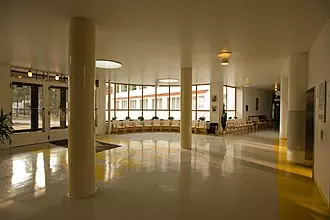 Interior of the sanatorium
Interior of the sanatorium
Tucked away in the serene landscapes of Paimio, Southwest Finland, stands a gem of modernist architecture - the Paimio Sanatorium. Designed by the renowned Finnish architect Alvar Aalto, this former tuberculosis sanatorium has left an indelible mark on the world of design and healthcare.
A Testament to Innovation and Care
In the early 1930s, when tuberculosis was rampant, Alvar Aalto was entrusted with the task of creating a space where patients could heal both physically and emotionally. The result was an architectural masterpiece that seamlessly blended modernist principles with a human-centered approach.
 Postage stamp depicting the Paimio hospital building
Postage stamp depicting the Paimio hospital building
The Paimio Sanatorium, completed in 1933, garnered immense praise for its design, both in Finland and globally. Aalto's vision went beyond mere functionality; he transformed the very structure into a healing instrument. Patient rooms were thoughtfully designed to provide comfort and privacy, with each room housing only two patients. Special silent basins and strategically placed lighting ensured a peaceful environment conducive to recovery.
 Exhibition reconstruction of a sanatorium patient's room
Exhibition reconstruction of a sanatorium patient's room
But Aalto's innovation extended beyond the confines of patient rooms. Sunning balconies on each floor allowed weak patients to bask in the rejuvenating rays of the sun, while a sun deck on the top floor offered solace for those on the path to recovery. The sanatorium fostered a sense of community, with communal facilities, a chapel, staff housing, and picturesque promenade routes through the surrounding forest landscape.
A Living Testament
Today, the Paimio Sanatorium no longer functions as a hospital but has found new purpose as a private rehabilitation center for children. It continues to inspire and captivate visitors with its architectural brilliance. The Turku University Hospital, the current owner of the building, recognizes the historical and cultural significance of the sanatorium and has nominated it to become a UNESCO World Heritage Site.
Conclusion
The Paimio Sanatorium stands as a timeless tribute to Alvar Aalto's genius and his passion for creating spaces that promote healing and well-being. Its innovative design and meticulously crafted interiors provide a testament to the power of architecture in enhancing the human experience. A visit to this architectural marvel is not just a journey through history but an opportunity to immerse oneself in the transformative potential of design.
References:
- Margaretha Ehrström, Sirkkaliisa Jetsonen, and Tommi Lindh, Nomination of Paimio Hospital for Inclusion in the World Heritage List. Museovirasto, Helsinki, 2005.
- Marianna Heikinheimo (2013): Functionalism and Technology, p. 73-79.
- Göran Schildt, Alvar Aalto. The Early Years. Rizzoli, New York, 1984.









